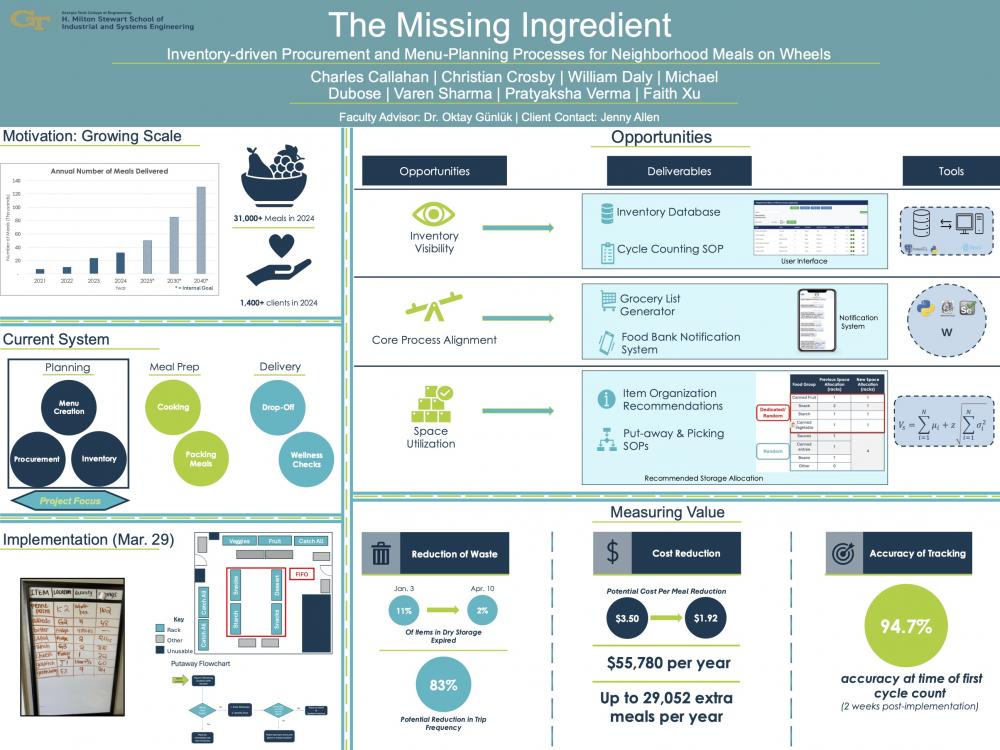Client Context
Founded in 1979, Neighborhood Meals on Wheels (NMOW) is a nonprofit organization that prepares, packages, and delivers nutritious meals every weekday directly to the homes of senior citizens in the Gwinnett County area. Meals are prepared by cooking volunteers overseen by one manager in the morning, then picked up and delivered by driving volunteers around noon. Daily delivery allows drivers to perform wellness checks on the seniors. NMOW’s initiatives aim to prolong the independence of those in old age, allowing them to stay in their own homes for longer with relative autonomy.
The client’s primary concern is the projected growth in demand for their services due to the rising population of seniors in Gwinnett County. Between 2021 and 2024, NMOW’s annual meal deliveries grew from 7,000 to over 35,000 and their goal is to deliver 50,000 meals in 2025.
Project Objective
The objective of this project was to deliver the client with tools that enable them to make data driven decisions about their three core planning processes: menu creation, procurement, and inventory storage. This alignment will enable reductions in waste, reductions in grocery trip frequency, better inventory visibility, and reduced costs, enabling the client to feed more people on a limited budget.
Design Strategy
Increasing Inventory Visibility
After thoroughly analyzing NMOW's current system, one of the largest opportunities identified was improving inventory visibility. Before implementation, there was no recollection of brand, available servings, container type, or even expiration dates. In the initial stock taken in January 2025, 11% of products in dry storage were expired. This wastes valuable storage space. Additionally, 7.1% of frozen inventory items were lost due to freezer burn, often stemming from a lack of visibility that causes volunteers to dig through multiple freezers to obtain necessary ingredients. To rectify this the team determined that a user friendly application where the client could view and edit the inventory could bring newfound visibility to their operations.
Aligning Core Planning Processes
The second opportunity is better aligning NMOW’s core planning processes with each other. In the current system, menu creation, procurement, and inventory processes interact in an ad hoc manner, which results in frequent grocery trips. A big potential opportunity in terms of cost savings is to procure more items from the food bank. NMOW only made 7 orders from ACFB in 2024 despite its prices being significantly cheaper than retail grocery stores. The low number of orders was largely due to insufficient storage space to take in such large orders. The approach to solving this was to create digital tools that allow the client to use available inventory data to make meal planning and procurement decisions based on what is in stock, in order to reduce grocery trip frequency and increase the amount of available space for food bank orders. Additionally, the team wanted to deliver a tool that would allow them to purchase more competitively from the food bank.
Improving Space Utilization
The third opportunity is improving dry storage space utilization. NMOW has expressed an internal goal to be able to store five weeks of inventory at a time. Items are assigned to racks based on item category, of which there are eight core categories. To address the overflowing dry storage area, the team analyzed how the client uses the items in the space. The nature of NMOW’s Stock Keeping Unit (SKU) distribution is unpredictable, as they procure items from many different sources and brands, and thus there is no fixed set of SKUs by which to approximate space demand. Using a randomized storage model, the team calculated the amount of space needed to satisfy 5 weeks of demand across all of the major categories.
Deliverables
The team’s approach is centered around a fully implemented database and application. The application features four main tools, the inventory view where items can be added and removed from storage, an expiration date tracker, a menu feasibility checker, and a grocery list generator. This app ultimately enhances inventory tracking and enables data driven alignment of core processes like procurement, menu planning, and storage. To help the client be more competitive in procuring Atlanta Community Food Bank Items, the team developed and implemented a notification system that alerts NMOW when preferred items become available. In addition, the team made several changes to warehouse organization and procedures to streamline processes and ensure that space is allocated efficiently. These solutions will ultimately allow them to increase their output without sacrificing quality or freshness.
Value and Impact
Since implementation, the application has helped reduce waste from 11% of all items in January 2025 to 2% as of April 2025. The menu feasibility and grocery list tools have the potential to reduce the rate of grocery visits by up to 83%. With the food bank notification system and other tools, NMOW has the opportunity for up to a 45% reduction in cost per meal, providing the potential to produce up to 29,000 more meals per year with the same facility and resources.


